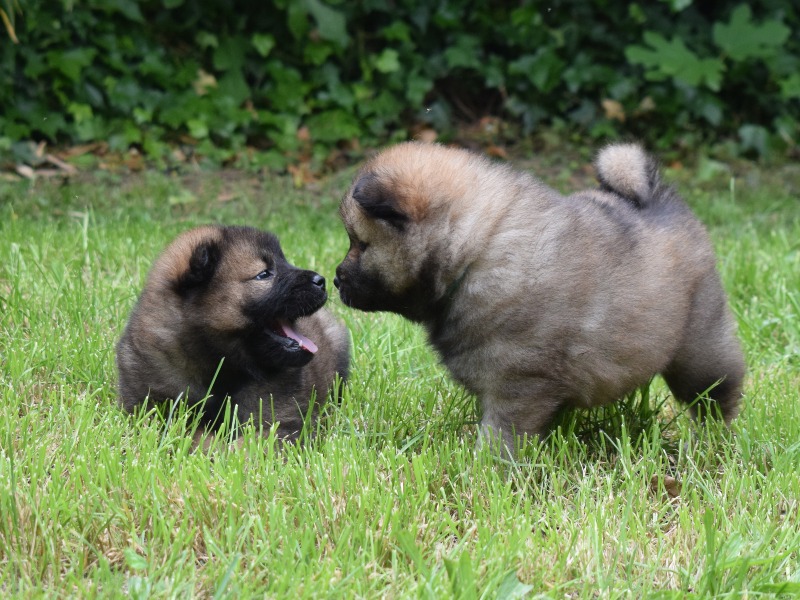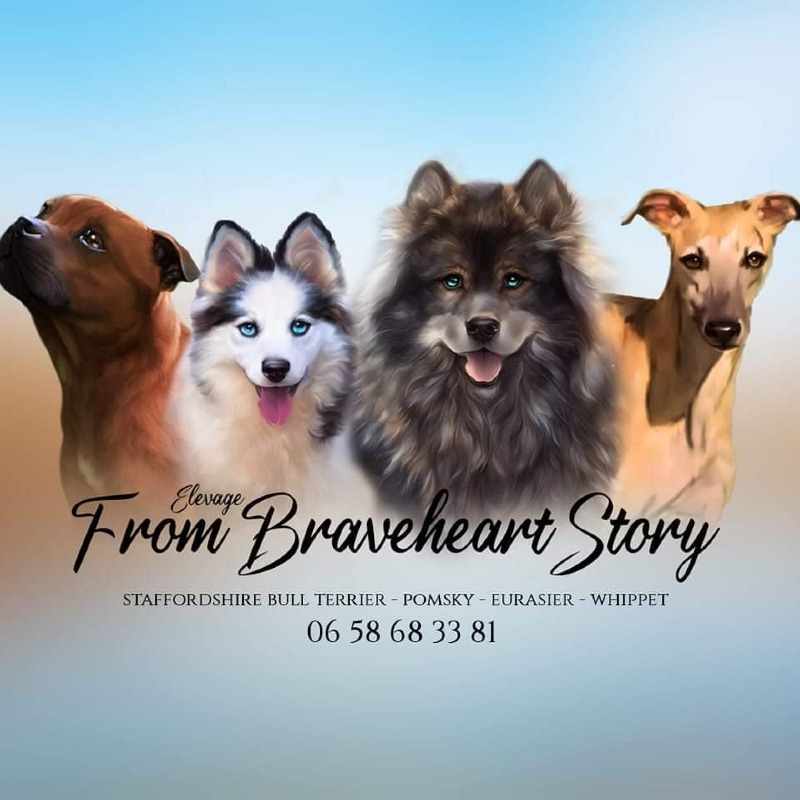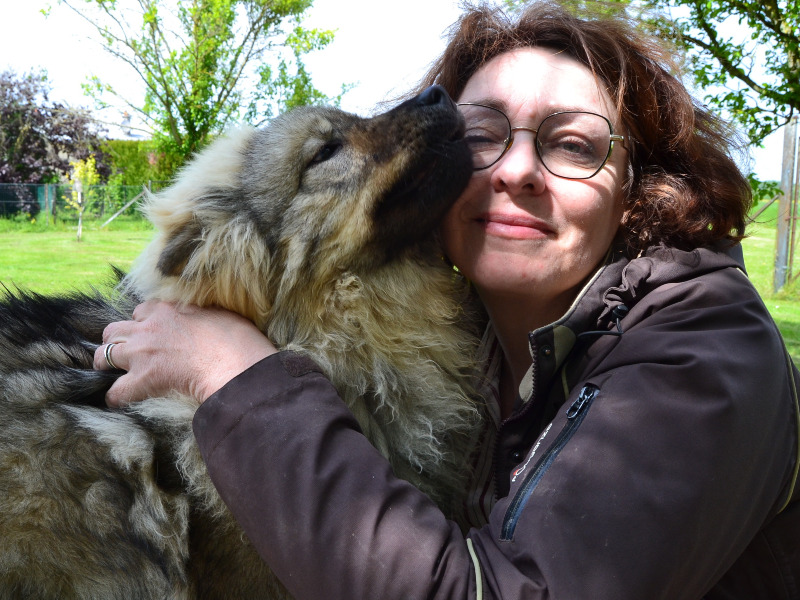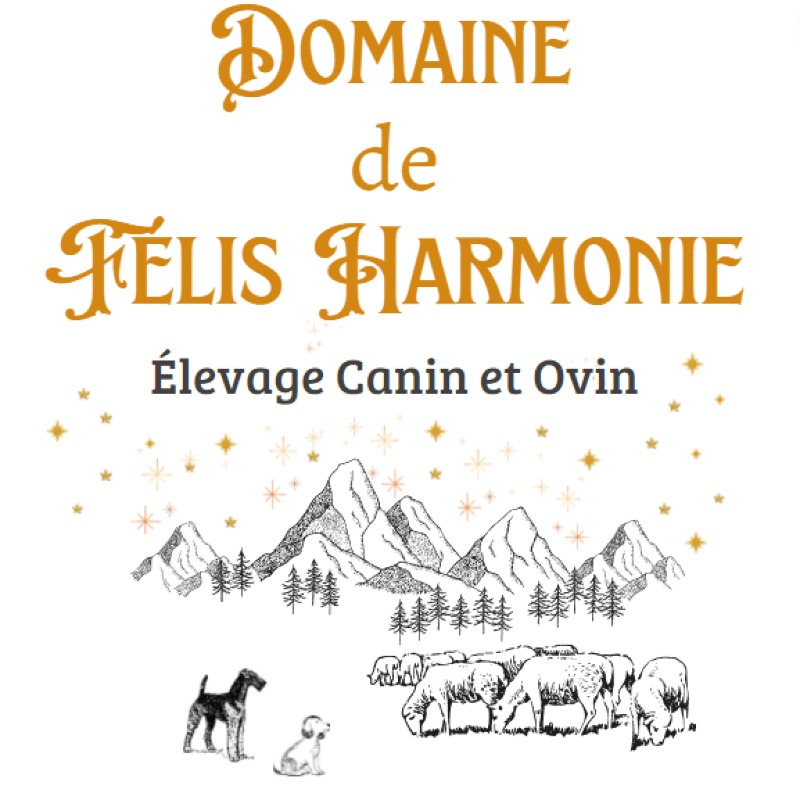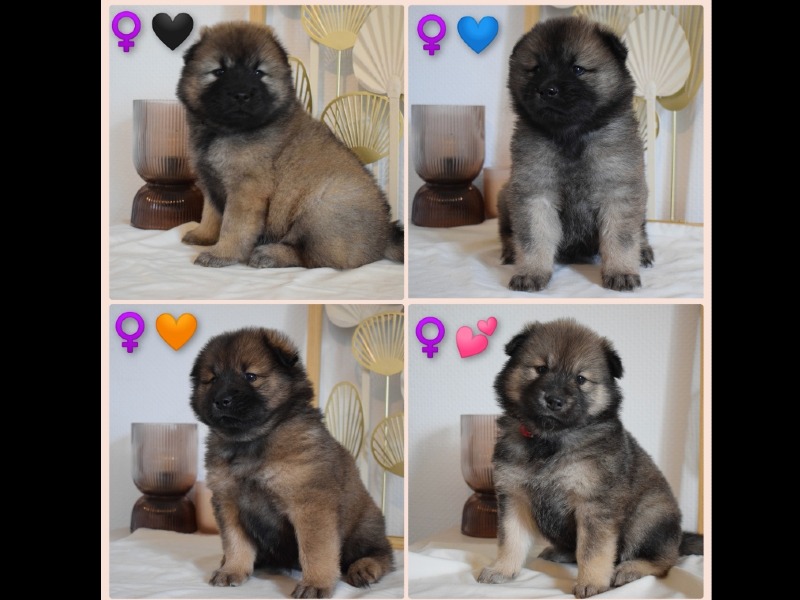Eurasian
Welcome to our page dedicated to the breed of dog eurasian!
Here, you will find all the useful information about eurasian. This descriptive profile will allow you to discover the aspects of this breed. You can notably consult information about the average price, monthly and annual upkeep expenses, their health, name ideas, as well as their official recognition by competent authorities.
Explore this page to discover everything you need to know.
Overall description of the breed
The Eurasier was created and developed in Germany in the middle of the 20th century, this breed is the result of several crosses between the German Spitz, the Chow-chow and the Samoyed. The ethologist Konrad Lorenz (Nobel Prize in Medicine), together with an experienced dog breeder, Julius Wipfel, took the initiative to revive an ancestral breed called the Nenets Laika.
The result of this selection work was beyond their expectations and he named it the Eurasier, which thanks to its name mixes breed dogs from the Asian and European continents. Thanks to the renewed interest, it was recognised by the International Cynological Federation on 27 July 1973. Its appealing appearance made it very popular in Germany, Belgium, Switzerland and Spain during the following decades, but it is not very widespread outside the European continent. The latest update of the official standard in force was published on 4 September 2019.
The Eurasier has all the qualities of an excellent companion dog, robust, intelligent and pleasant to live with. The Eurasier is a medium to large dog, its population remains low in Europe, but its sociability makes it a companion that deserves to be known by as many people as possible! His body is as long as it is high, so he fits into a square, balanced and homogeneous, he has a good developed muscular structure, a solid bone structure as well as a generous depth of chest.
His head is of a rounded Spitz type, nicely drawn, his muzzle is of medium length and his stop not very marked. His tail is long and abundantly coated, it can be straight or curved over the back. The coat is long or medium long depending on the part of the body, of soft and voluminous texture, all shades are permitted except plain white or white and brown.
The Eurasier is endowed with a supple, docile character, always benevolent towards humans as well as other animals, it is a trustworthy dog, easy to live with and to maintain. Of a jovial nature, he appreciates enormously the moments of games and sharing in family, the ludic activities or of training suit him perfectly, because he has a great intelligence.
A good guardian, he remains wary of people he does not know, particularly attached to his family, he will need time to adapt to feel fully confident. Despite being little known to the general public, the Eurasier proves to be a wonderful companion, faithful, loving and demonstrative, if you are lucky enough to discover this breed, it will quickly become the mascot of the whole family.
Adult: The Eurasier will weigh 55 to 66 lbs for males and 44 to 55 lbs for females, its height at the withers will be approximately 20.4" to 23.6" for males and 18.9" to 22" for females.
Awareness of acquiring an animal
Each animal is a sensitive being, deserving love, attention and care.
When you choose to adopt an animal, you take on the responsibility of ensuring its health and well-being throughout its life.
To learn more about animal welfare, we invite you to consult our FAQ by clicking the button below:
Origins
The Eurasier is a relatively recent dog breed originating from Germany. Created in the 1960s by Julius Wipfel, the breed resulted from crossings between the Chow-Chow, the Spitz-Wolf (Keeshond) and later the Samoyed. The goal was to develop a balanced and well-adapted family pet. The name "Eurasier" reflects its European and Asian origins. This unique combination of breeds has resulted in a dog with a calm temperament and a beautiful coat.
History
The history of the Eurasier began in the 1960s in Germany, thanks to the efforts of Julius Wipfel and his team of cynologists. They first crossed the Chow-Chow with the Spitz-Wolf (Keeshond) to obtain the basic Eurasier, also called Wolf-Chow. Later, Samoyeds were introduced into the breeding program to improve sociability and soften the character. The breed quickly gained popularity in Europe and was officially recognized by the Fédération Cynologique Internationale (FCI) in 1973.
Standard
The Eurasier standard describes a medium-sized, harmonious and well-proportioned dog. Males measure between 52 and 60 cm at the withers, while females measure between 48 and 56 cm. Their weight varies from 18 to 32 kg. Their coat is dense and of medium length, with a thick undercoat. The coat colors may include fawn, black, sand and wolf gray. The head is medium-sized with dark and expressive eyes, and the ears are triangular and erect. The body is muscular with a well-furnished tail carried curled over the back.
Physical characteristics
The Eurasier is a medium-sized dog, measuring between 52 and 60 cm for males and between 48 and 56 cm for females, with a weight ranging from 18 to 32 kg. Its coat is dense and of medium length, with a thick undercoat, offering good protection against bad weather. Colors can vary, including fawn, black, sand, and wolf grey. The head is proportionate with dark and expressive eyes, and erect triangular ears. The body is muscular and well-proportioned, with a bushy tail curled over the back.
Character
The Eurasier is known for its balanced, calm, and affectionate character. It is an intelligent and sensitive dog, very attached to its family. It is reserved but not shy, and can be distant with strangers without being aggressive. The Eurasier is an excellent companion dog, loving towards children and getting along well with other pets. Its need for closeness to its family makes it a dog that does not like to be left alone for long periods. Its gentleness and stable temperament make it an ideal companion for various family environments.
Life expectancy
The average life expectancy of the Eurasier is generally 12 to 14 years. To ensure a long and healthy life, it is essential to provide them with a balanced diet, regular veterinary care, and lots of love. Regular visits to the vet help to quickly detect and treat any potential illnesses. By providing the Eurasier with ongoing attention and a healthy lifestyle, owners can maximize their life expectancy and ensure that they remain a happy and healthy companion throughout their life.
Exercise and activity needs
The Eurasier has moderate exercise needs. It enjoys daily walks, playtime, and interactive games. Although calm indoors, it needs regular exercise to maintain its physical and mental health. Activities like hiking, fetch games, and canine sports can be beneficial. A stimulating environment and regular interactions with its family are essential to prevent boredom and destructive behaviors. The Eurasier is adaptable, but thrives in an active and engaging environment.
Recommended diet
The Eurasier's diet must be balanced and adapted to its age, weight, and activity level. A high-quality food rich in proteins and essential nutrients is recommended. Portions should be monitored to avoid overweight. A diet including premium kibble, supplemented with fresh foods such as meat, vegetables, and fruits, may be ideal. It is important to regularly consult a veterinarian to adjust its diet according to its specific needs and to ensure optimal health.
Training and obedience
The Eurasier's education should begin at a young age. Intelligent and eager to please, he responds well to consistent and positive training. Positive reinforcement methods, such as rewards and praise, are particularly effective for this breed. Early socialization is crucial to familiarize him with different people, animals, and environments. Patience and consistency are essential for successful training. The Eurasier learns quickly, but can sometimes be stubborn, so short and regular training sessions are recommended to maintain his interest.
Behavior with children
The Eurasier is generally very good with children. Its gentle and affectionate nature makes it an excellent companion for families. It tolerates children's games well and enjoys their company. However, as with all dogs, it is important to supervise interactions to ensure they are safe. Teaching children to respect the dog and be gentle with it will contribute to a harmonious and incident-free relationship. Its patience and gentleness make it a precious friend for young children, ready to participate in their activities.
Compatibility with Other Animals
The Eurasier is generally sociable and gets along well with other pets, especially if properly socialized from a young age. It can peacefully coexist with other dogs and even with cats. Its gentle and friendly nature facilitates positive interactions with its fellow dogs. However, as with all dogs, appropriate introductions and initial supervision are recommended to ensure that interactions go smoothly. Its peaceful nature makes it adaptable to different living environments.
Grooming needs
The grooming of the Eurasier requires regular attention due to its dense and double coat. Weekly brushing is recommended to prevent knots and tangles, as well as to remove debris and dead hair. During shedding periods, more frequent brushing may be necessary to manage hair loss. It is also important to check and clean its ears to prevent infections. Nails should be trimmed regularly, and occasional baths will help maintain a clean and healthy coat. Regular dental care is also essential to prevent dental problems.
Health
The Eurasier is generally a robust breed with few major health problems. However, as with all breeds, some health issues can occur. Common conditions include hip dysplasia, eye problems, and skin conditions. A balanced diet, regular exercise, and frequent veterinary visits help maintain its health. Prevention through regular care and attention to signs of illness is essential for ensuring a long and healthy life. Genetic health tests can also be helpful in detecting and preventing certain hereditary diseases.
Average price
The price of a Eurasier puppy can vary considerably depending on several factors, including the reputation of the breeder, the lineage of the parents, and the geographical region. In general, you can expect to pay between 1,000 and 2,000 euros (or between 1,100 and 2,200 dollars) for a puppy of this breed. It is important to choose a reputable breeder who adheres to the breed standards and conducts the necessary health tests to ensure the puppies' good health. A responsible breeder will also provide you with information on caring for and training the puppy.
Expenses
Annual expenses for a Eurasier include food, veterinary care, grooming, and various accessories. For food, you should budget around 500 to 700 euros (550 to 770 dollars) per year. Routine veterinary care, including vaccines and annual check-ups, can cost around 300 to 500 euros (330 to 550 dollars). Grooming, depending on the frequency and location, can represent an annual cost of 100 to 300 euros (110 to 330 dollars). Accessories and toys can add around 100 to 200 euros (110 to 220 dollars) per year.
Name ideas
Choosing a name for an Eurasier can be a fun task. For a male, "Lupo" evokes its Spitz-Wolf origins. "Baïkal" could recall its Russian roots. "Tao" means "path" in Chinese, symbolizing its balance. For a female, "Mishka" means "small bear" in Russian, reflecting its gentle appearance. "Nala" symbolizes beauty. "Sierra" evokes mountains. Other names like "Kodiak" for its robustness, "Luna" for its gentleness, "Zephyr" for its tranquility, and "Aurora" for its beauty are also appropriate.
Legislation and regulation
Regarding legislation and regulation, the Eurasier is not subject to any particular prohibition. As with all dogs, it is important to comply with local laws regarding registration, vaccination, and pet control. Owners must also ensure that their dog is well trained and socialized to prevent any problematic behavior. Rules may vary by country and region, so it is advisable to inquire with local authorities.
Official recognition
The Eurasier is registered under standard n°291. Recognized by the VDH (Verband für das Deutsche Hundewesen) in Germany, the KC (The Kennel Club) in the United Kingdom, the LOF (Livres des Origines Françaises) in France or the CKC (Canada Kennel Club) in Canada, all of which are dependent on the Fédération Cynologique Internationale (FCI). In Germany, the official organization that handles this breed is the Eurasier Klub e.V. This organization works on promoting, preserving, and improving the breed through rigorous breeding programs and exhibitions.
Pedigrees
Eurasier pedigrees are available from various breed clubs and kennel clubs. These documents provide detailed information on the dog's lineage, including the medical history and show successes of its ancestors. In Germany, the Eurasier Klub e.V. and the Fédération Cynologique Internationale (FCI) are primary sources for obtaining these pedigrees. These documents are essential for breeders and owners looking to understand and preserve the genetic qualities of the breed. A reliable pedigree also ensures that the dog comes from a responsible breeding that respects the standards.
Destination and usage
The Eurasier is primarily intended to be a companion dog, appreciated for its gentle and affectionate nature. Although initially developed to combine the qualities of various breeds, it now excels as a family companion. Its intelligence and balanced character make it suitable for various living environments. It enjoys participating in leisure activities and can also excel in disciplines such as agility and obedience. Its sociable nature and attachment to its family make it an excellent family dog.
Prohibitions
According to our research, Eurasier is not subject to any specific ban in countries or regions of the world. However, it is crucial for owners to inquire about local laws concerning dogs, as regulations can vary significantly from one place to another. Some regions may impose specific restrictions on owning certain dog breeds or establish strict rules regarding the care and control of pets. Compliance with these rules is essential to ensure harmonious coexistence with the local community.
Breeders ofEurasian
Want to see more breeders ofEurasian?
Check out the page of our directory listing all breeders ofEurasianClassified Ads ofEurasian
Breed clubs ofeurasian
No ofeurasian breed clubs are currently registered on Preeders.
If you would like to highlight your breed club, sign up for free now and be the first to appear on this page.

